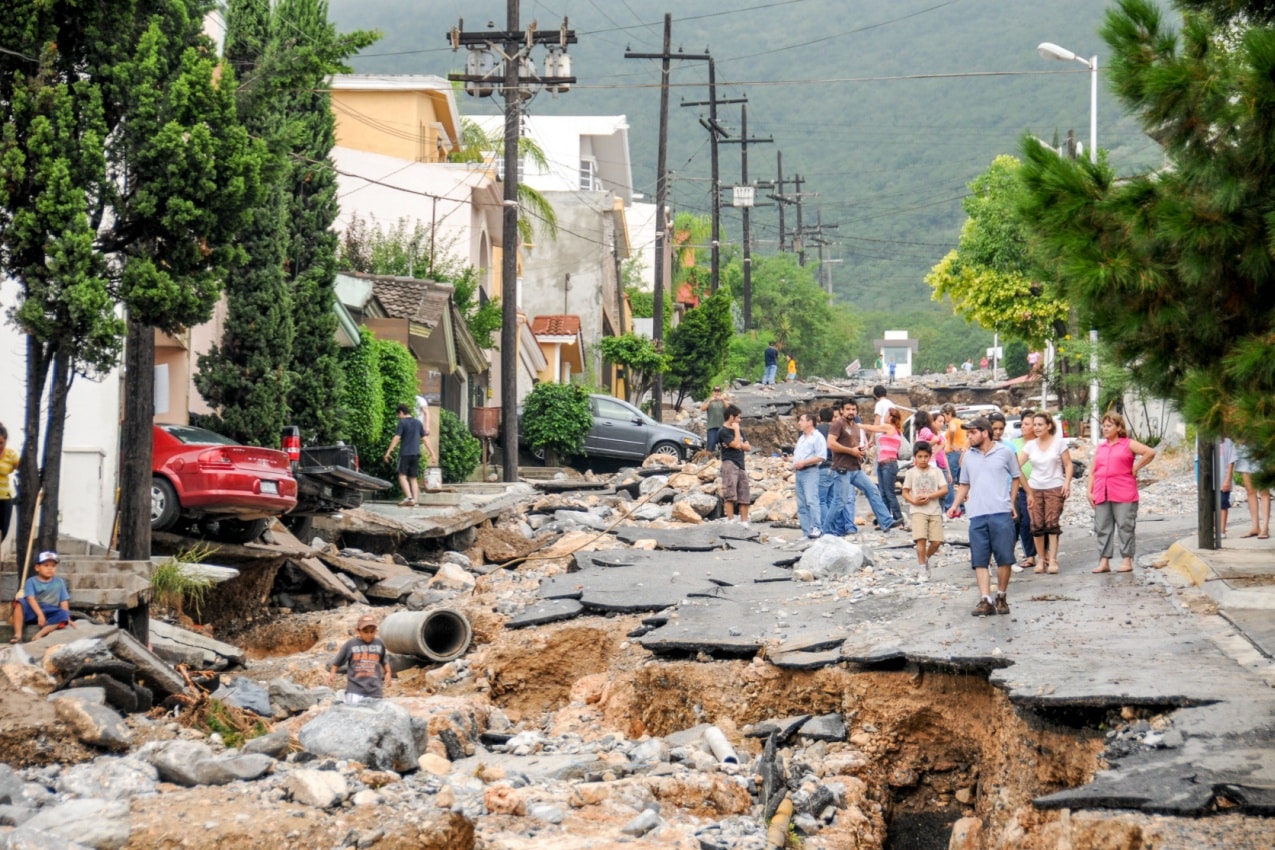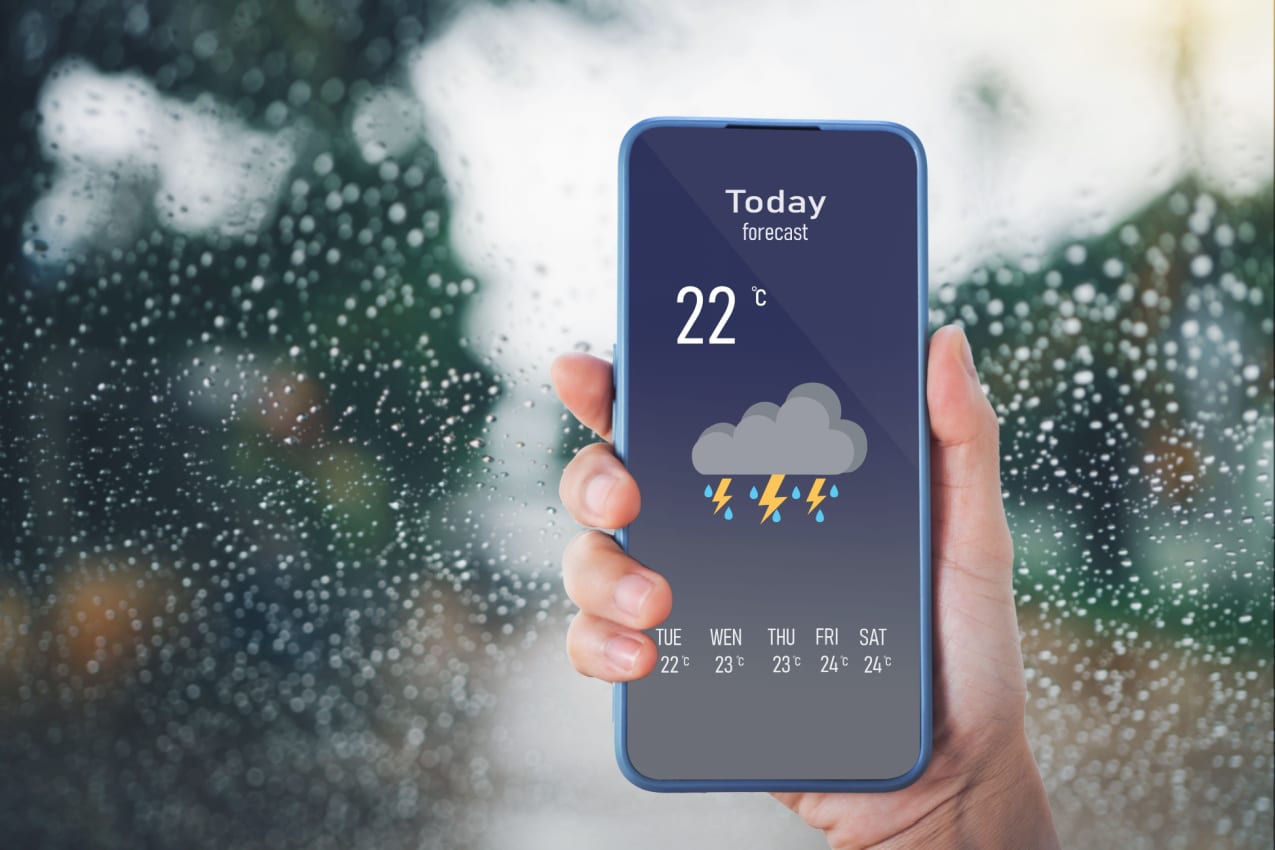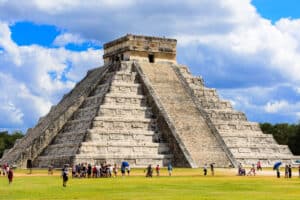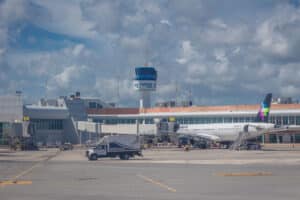Mexico has survived 79 major natural disasters since 1980. Half of those natural disasters were caused by tropical cyclones, while one-fourth were caused by geological events, such as volcanic eruptions, landslides, and earthquakes.
If you are visiting or relocating to Mexico, you should be aware of the potential natural hazards, as well as how to protect yourself in an emergency.
Mexico’s Natural Disasters: The Most Common Hazards in the Land of Enchantment

Mexico’s diverse topography exposes it to a spectrum of natural disasters that have tested its resilience and defined its history.
The most common include tropical cyclones, floods, earthquakes, volcanic eruptions, and landslides.
Let’s go over each natural disaster to reveal the historical records of their occurrences and help you learn essential safety tips so that your traveling experience remains one of discovery, wonder, and, most importantly, safety.
Tropical Cyclones in Mexico and Their Destructive Potential
Tropical cyclones, often known as hurricanes or typhoons, are massive storms that occur over warm ocean waters, characterized by high winds, intense rainfall, and low-pressure centers.
Mexico is vulnerable to tropical cyclones due to its wide coastline along the Pacific Ocean, the Gulf of Mexico, and the Caribbean Sea. On average, the country suffers around 24 hurricanes per year.
The hurricane season in the Gulf of Mexico and the Caribbean Sea begins in June and ends in November, with peak activity typically between August and October.
In the Pacific Ocean, the hurricane season lasts from May 15 to November 30, a similar peak period spanning from August to October.
According to the Saffir-Simpson Hurricane Wind Scale, hurricanes are classified into five types, including:
- Category 1 Hurricane (Minimal damage): Wind speeds of 74-95 mph (119-153 km/h) and 5ft (1.4m) storm surge
- Category 2 Hurricane (Moderate damage): Wind speeds of 96-110 mph (154-177 km/h) and 8ft (2.4m) storm surge
- Category 3 Hurricane (Extensive damage): Wind speeds of 111-129 mph (178-208 km/h) and up to 12ft (3.6m) storm surge
- Category 4 Hurricane (Extreme damage): Wind speeds of 130-156 mph (209-251 km/h) and up to 18ft (5.4m) storm surge
- Category 5 Hurricane (Catastrophic damage): Wind speeds of 157 mph (252 km/h) or higher and a storm surge of more than 19ft (5.7m)
Some of the most destructive hurricanes that have hit Mexico in recent years include:
- Roslyn (Category 4 Hurricane): October 17-24, 2022
- Orlene (Category 4 Hurricane): September 26 to October 4, 2022
- Ian (Category 5 Hurricane): September 22 to October 1, 2022
- Iota (Category 4 Hurricane): November 12-18, 2020
- Eta (Category 4 Hurricane): October 31 to November 14, 2020
- Delta (Category 4 Hurricane): October 4-11, 2020
- Laura (Category 4 Hurricane): August 20-29, 2020
- Genevieve (Category 4 Hurricane): August 16-22, 2020
- Juliette (Category 3 Hurricane): September 1-9, 2019
These are only a few of the significant tropical cyclones that threaten Mexico’s coastal areas and towns. For more information about the most recent hurricanes and their magnitude, visit the official website of the National Hurricane Center.
Floods in Mexico and Areas at Risk
Floods are natural disasters triggered when a large amount of water overflows onto normally dry ground quickly.
These natural disasters can happen in a variety of circumstances, such as when there’s excessive rainfall, river overflow, hurricanes, rapid urbanization, and so on.
There’s a high risk of river floods and urban floods almost everywhere in Mexico, except in the states of Baja California Sur, Durango, Sinaloa, and Aguascalientes.
When it comes to coastal floods, all coastal states are endangered; however, the coastal floods are less severe in the states of Tamaulipas, Veracruz, Chiapas, Guerrero, Michoacan, and Colima.
The most destructive floods that have happened recently in Mexico are:
- 26 June, 2023 — Chiapas
- 4 February, 2023 — Tabasco
- 6 September, 2022— Nuevo León
- 8 August, 2022 — Sonora
- 1 June, 2022 — Oaxaca
- 7 October, 2021 — Querétaro
- 7 September, 2021 — Hidalgo
- 2 September, 2021 — Morelos
- 29 August, 2021 — Jalisco
- 19 August 2021 — Chihuahua
Flooding remains a big concern for Mexico due to its geographical diversity and climate fluctuation. If you want to remain up to date on the latest floods in Mexico or you want to read more about previous floods that happened there, visit the Floodlist website.
Volcanoes in Mexico and Past Eruptions
Volcanoes are geological formations that arise from the flow of molten rock from the Earth’s crust to the surface, known as magma.
Mexico is located on the Pacific Ring of Fire, a well-known hotspot of geological activity. When viewed from above, the Ring of Fire resembles a horseshoe around the Pacific Ocean.
Mexico has 36 “Holocene” volcanoes, which is a term used for volcanoes that have been active in the previous 11,700 years.
The most volcanically active locations in Mexico include the east-west volcanic belt that stretches through central Mexico, also known as the Trans-Mexican volcanic belt, and the region of Baja California.
As of 2023, Mexico has two active volcanoes: Popocatépetl, near Mexico City, which erupted recently, in June 2023, and Colima, around 75 miles (125 kilometers) south of Guadalajara, with its most recent eruption in July 2019.
Other notable volcanic eruptions include:
- The Paricutin eruption (1943-1952) — This is one of the most well-known examples of a volcano’s birth. The volcano erupted in a farmer’s field in Michoacán in 1943, and it was fully active for nearly a decade.
- El Chichón eruption (1982) — The El Chichón volcano is located in the Mexican state of Chiapas. The phenomenon lasted one week in a chain of three massive explosive eruptions.
- Jorullo eruption (1759-1774) — The Jorullo volcano emerged in Michoacán. Its first eruption occurred in 1759, and the volcano remained fully active for 15 years, until 1774.
These eruptions are just a few of the many volcanic events that have shaped Mexico’s history and landscape. If you want to stay up to date on recent volcanic activity in Mexico, go to the National Museum of Natural History Global Volcanism Program.
Mexico’s Earthquakes and Their Magnitude
Earthquakes are sudden releases of energy from the Earth’s crust, resulting in seismic waves that move through the Earth’s crust and produce shaking.
Earthquakes can range in magnitude — from barely felt small vibrations to large-scale disasters that result in great damage and fatalities.
The earthquake magnitude scale classifies earthquakes in the following six levels:
- Magnitude 2.5 or smaller — The smallest force of tremor that’s rarely felt.
- Magnitude 2.5 to 5.4 — Slight tremors and little infrastructure damage.
- Magnitude 5.5 to 6.0 — Strong tremors and slight harm.
- Magnitude 6.1 to 6.9 — Intense tremors and significant damage.
- Magnitude 7.0 to 7.9 — Severe tremors and large-scale damage.
- Magnitude 8.0 or greater — The most powerful earthquake, capable of completely destroying settlements surrounding the epicenter.
As we already mentioned, Mexico is located in the Pacific Ring of Fire, a seismically active zone with tectonic plate borders and volcanic activity, making this country extremely prone to earthquakes.
Some of the Mexican states least affected by earthquakes are Chihuahua, Coahuila, Durango, Nuevo Leon, San Luis Potosi, Aguascalientes, and Yucatan.
The rest of Mexico is highly susceptible to earthquakes. Some of the most damaging ones include:
- 1973 Colima Earthquake — A magnitude of 7.5
- 1985 Mexico City Earthquake — A magnitude 8.1
- 2012 Guerrero-Oaxaca Earthquake — A magnitude of 7.4
- 2017 Chiapas Earthquake — A magnitude 8.2
- 2017 Puebla Earthquake — a magnitude 7.1
- 2020 Oaxaca Earthquake — A magnitude 7.4
These are just a few of the most powerful earthquakes that have occurred recently in Mexico, but the country experiences over 30,000 earthquakes per year, which is a staggering figure.
For more information about the most recent earthquakes, visit the online earthquake tracker EarthquakeList. You can also download the 911 CDMX app on your phone that will give you an earthquake warning 60 seconds before it occurs.
The Force and Impact of Mexico’s Landslides
A landslide is the collapse of a mass of rock, ruins, or soil down a slope.
The main causes of landslides include rainfall, snowmelt, changes in water level, stream erosion, changes in groundwater, earthquakes, volcanic activity, or disturbance by human activities.
The states with the lowest chance of landslides include Yucatan, Quintana Roo, Campeche, and Sinaloa. The remainder of Mexico is categorized as having a high risk of possible landslides.
Some of the most destructive landslides that have happened in Mexico are:
- July, 2007 — Eloxochitlan, Puebla
- September, 2010 — Santa Maria Tlahuitoltepec, Oaxaca
- September, 2013 — La Colonia Manzanatitla, Coscomatepec, Veracruz
- September, 2013 — La Pintada, Sonora
- August, 2016 — several areas in central Mexico
- August, 2016 — Coscomatepec and Tequila, Puebla
- September, 2021 — Cerro del Chiquihuite Hill, Mexico City
- June, 2022 — Santa Catarina Xanaguia, Oaxaca
Since landslides can be caused by different geological, environmental, and human factors, it’s necessary to follow the most recent weather reports as well as news on potential earthquakes and volcanic eruptions.
Essential Tips & Tricks to Protect Yourself in the Event of a Natural Disaster

Now that we’ve shared the most important information about Mexico’s most prevalent natural disasters, it’s time to ensure your visit remains as safe as possible.
Crucial Safety Tips for All Natural Disasters
- Save the following emergency numbers: 080 for fire hazards, 066 for medical assistance, and 911 for police
- Prepare an emergency supply kit that includes food, water, medicine, flashlights, extra batteries, portable chargers, important documents, and clothes
- Find the closest shelter and all the routes you can take to get there from your current location
- Fill up your car’s gas tank to get it ready in case of an evacuation
- Try to stay calm, as panic can result in wrong judgment and risky actions
- Obey the official’s instructions related to the emergency in question — if evacuation is in effect, leave the area right away by using the designated routes
- Use a whistle or a flashlight to call for help if you are stranded and in need of assistance
- Expect delayed flights in case of a natural disaster
How to Remain Safe During a Tropical Cyclone?
- Watch the weather reports
- Book lodgings that can survive storms and hurricanes
- Ask the property owners about their hurricane evacuation plans and emergency procedures
- Remain inside and stay near windows
- Protect outdoor objects that might affected by strong winds
- Avoid visiting the beach during storms or hurricanes
How to Remain Safe During a Flood?
- Follow weather forecasts
- Book at hotels or rental properties that are higher up rather than in coastal areas and low-lying places.
- Never drive or walk through flooded areas
- Don’t go to basements and other underground areas
- Have an emergency life vest
- Lift your possessions off the ground and place them someplace high in case your room starts to flood
How to Remain Safe During a Volcanic Eruption?
- Avoid going od driving close to the volcano, especially as it’s erupting
- Stay inside and shut the doors and windows if there’s volcanic ash falling
- If you need to evacuate, wear long-sleeved clothing, a hat, glasses, and a mask (preferably an N95) to protect yourself from volcanic ash
- Avoid booking in low-lying locations that are more prone to ash deposition and lava flows
How to Remain Safe During an Earthquake?
- If you feel the ground shaking, remember to “Drop, Cover, and Hold On” — this means dropping on your hands and knees, taking cover under a sturdy piece of furniture, such as a table or desk, and holding on there until the shaking stops
- Stay away from windows
- Double-check your hotel room for possible damage like gas leaks, fires, and structural damage
- If you’re outside during the tremor, run to an open area, away from buildings, trees, or streetlights that may collapse
- If you’re driving, pull over to an open location and remain in your car until the trembling stops
- Aftershocks can occur after an initial quake — be prepared for further tremors
How to Remain Safe During a Landslide?
- Landslides can make a roaring sound similar to an incoming freight train — if you hear this sound, run away from that area
- Move to higher ground, climb uphill, and farther away from the potential slide’s area
- Avoid areas with rivers and rocky terrain, where landslides are more likely
- If you are indoors, move to an upper floor and avoid rooms on the main floor or basement
Conclusion
The range of terrain that makes Mexico so appealing to tourists also makes it vulnerable to a variety of natural calamities.
In this article, we provided travelers with essential knowledge about what these disasters entail, their historical occurrences, and, most importantly — how to stay safe in the face of such danger.
So, whether you’re planning a vacation to the bustling streets of Mexico City, the tranquil beaches of Cozumel, or the historic ruins of Chichen Itza, you’re now well-equipped with information on how to stay safe.
Your dream vacation awaits!



